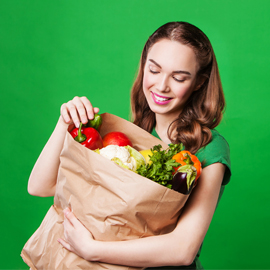
Keeping healthy ingredients in your kitchen makes it easier to cook healthy meals. But how do you get these nutritious foods from the grocery store to your kitchen without giving in to the temptation of buying Double-Stuffed Oreos and barbecue-flavor potato chips? And how do you know what you are buying is as healthy for you as it claims to be on the label?
Eat Protein Before Going Food Shopping
In other words, don’t just grab a cart and start browsing aisles stocked full of easy-to-munch junk food if your stomach is making angry bear noises. When your stomach tells your brain it needs food, there isn’t much you can do to override this command. Study after study has found that people who try to stick to healthy shopping habits when hungry end up with unhealthy food choices in their cart–and eating them later at home.
Beware the Warehouses
Buying foods in bulk may be a bit cheaper but sometimes these deals can facilitate overeating once you have all this food in your home. Instead of leaving 20 boxes of oatmeal mix in your cupboard, take one or two boxes and store the rest somewhere that will make it difficult for you to access them, such as in the corner of a basement or garage.
Lists, Lists, Lists
Making lists is a good thing. It organizes, categorizes and even helps procrastinators avoid procrastinating. Making a healthy shopping grocery list and sticking to it is one of the best ways to leave your supermarket with exactly what you need–nutritious, low-fat, low-sugar foods.
Nutrition Fact Sheet
The Nutrition.gov website provides a handy nutrition fact sheet to help make shopping for the right foods easier and quicker. According to the facts, avoid foods that are high in saturated fats, trans-fats, cholesterol and sodium and buy more foods containing fiber, vitamins C, A and E, iron, calcium, magnesium and potassium.
Labels Can be Misleading
Healthy shopping tips also include paying attention to serving size information pertaining to calories, protein, carbohydrates and fat. Much of the packaging on a container is marketing and designed to make you buy. Learning to read a nutrition labels is one of the easiest ways to ensure the food you are buying is exactly what you thought it was.

Leave a Reply